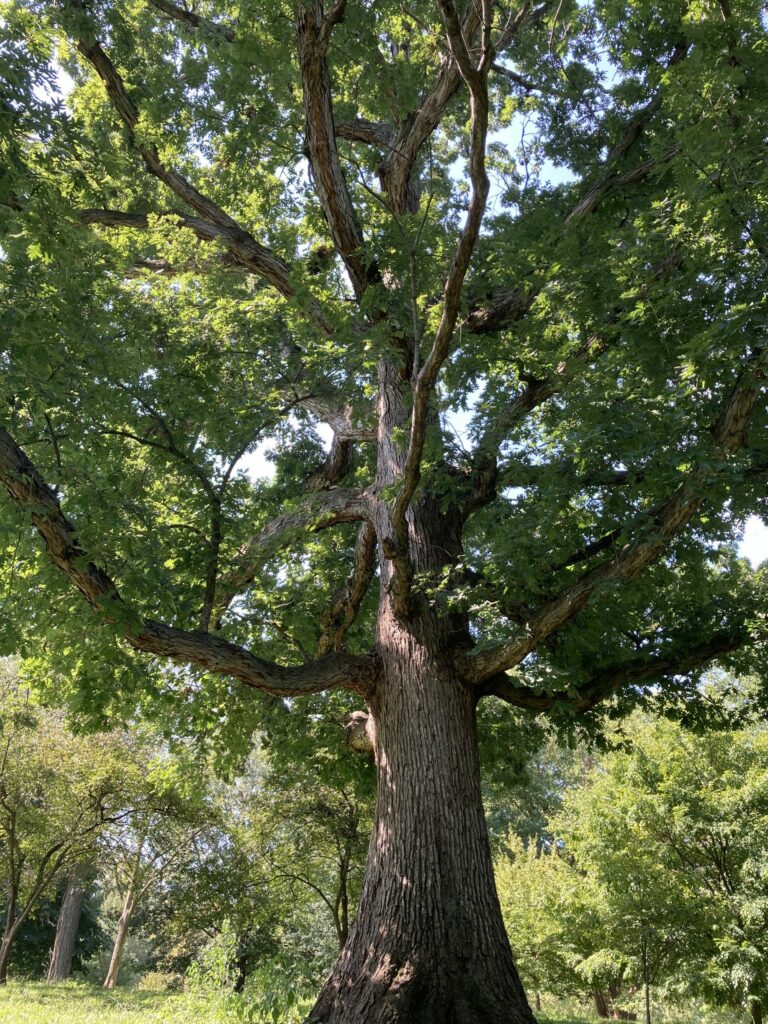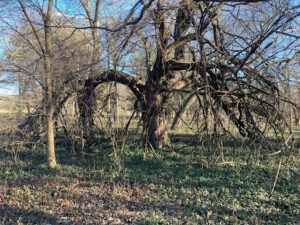By: Mark Halpin, Forestry Manager
The white oak (Quercus alba), at least in these parts, is the Cadillac of Canopy, the King and Queen (oaks are monoecious) of the Forest, the Sheik of Shade. Only its close relatives the bur oak and southern live oak cast the same noble presence over the land – go ahead and ask for an autograph, it’s a true celebrity. 100 feet in height and spread is not uncommon at maturity, with exceptional specimens approaching 150. Such trees might be 200, 400, even 600 years old. Unfortunately such behemoths are harder to come by each year, for white oak grows quite slowly. But its slow growth is the very essence of its strength; the wood is dense, smooth-grained, and exceptionally strong as both live wood and lumber. It is unparalleled in terms of wildlife benefits, with over 600 insect species calling it home. The acorns are among the sweetest of all the oaks. Even humans can eat them, although their flavor is best when they are ground and leached to remove tannins. This “acorn meal” was an important and highly nutritious food for indigenous Americans living within the white oak’s range.
“White oak” is not only one species, but also a name applied to an entire family of oaks that have round-lobed leaves, acorns that mature in one year, and grow more slowly than their counterparts in the red oak family (members of each family can hybridize with each other, but not with members of the other family). White oak wood is also filled with tyloses, cellular growths that plug up old, out-of-use vascular tissue to prevent the unwanted movement of pathogens. This increases its density and strength, but also gives it a unique quality that has made it one of the most important lumber sources on earth; it is water tight. More importantly, it is alcohol tight.
All fine whiskeys, brandies, cognacs, rums, most fine wines and even some beers and cocktails are aged in white oak. As these beverages sit in their barrels, the seasonal temperature fluctuations cause the wood to swell and contract, in turn allowing the liquid to seep in and out. With each movement it leaches out some of the sugars, tannins, vanillins and other flavors trapped in the wood. Anyone who has tasted unaged “white dog” whiskey or clear brandy can attest to the fact that without white oak’s mellowing characteristics, these drinks can be pretty rough customers.
Sadly, in the great oak forests of North America where much of the world’s barrel stave wood is grown, white oak is regenerating at an alarmingly slow rate. In response to this crisis, a number of industries, organizations and agencies have joined together to form the White Oak Initiative ( https://www.whiteoakinitiative.org/) to ensure that its regeneration continues. The result is pleasantly surprising – huge corporations contributing to a project that won’t really benefit them for several decades or more, and one with an enormous ecological benefit as well. Now if we could just get more industries to realize that we’re all dependent on natural resources…
Owners of forested land suitable for white oak should do everything possible to encourage its growth, even if they have no intention of ever harvesting it, to help ensure a genetically diverse seed bank for the future and to benefit the wildlife that inhabits their land. Land managers of every other kind should include Q. alba or other members of the white oak family in their plantings as well – there are few finer gifts you can provide to future generations than a mature white oak. Plant one soon for your great grandchildren, and all the other fine critters of the earth.
As usual, pictures don’t do this fine specimen justice! Better go find one for yourself to enjoy in person.




